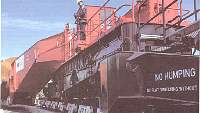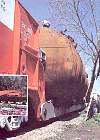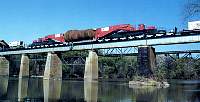"Nuclear generators ride the Schnabel to Cherokee"
The following pictures and text were taken from the July/August 1982 issue of
Norfolk Southern World Magazine.
How do you ship steam generators that weigh 790 tons? You use the
world's largest rail car, a 370-ton car that's 287-feet, l0-inches long
when loaded and 18-feet high unloaded.
Southern Railway did exactly that when two steam generators were moved
recently from near Charleston, S.C., to Duke Power Company's Cherokee
Nuclear Station near Gafney, S.C. CSX also helped make the delivery.
Together, the car and one of the generators weighed 2,308,086 pounds.
This was the largest and heaviest shipment ever to move by rail.
The generators rode atop a 36 axle Schnabel rail car owned by
Combustion Engineering of Windsor, Conn. Making three trips--each
ranging from three to six days and covering over 300 miles one way--the
car transported a total shipment of more than 2,000 tons of nuclear
generator components.
Manufactured at Combustion Engineering's Chattanooga facility,
the components--two 790-ton steam generators and a 490-ton reactor
vessel-were shipped by barge to the Bushy Park industrial area in Goose
Creek about 15 miles north of Charleston.
The barge arrived in Charleston after a 12 day, 2,600-mile trip on the
Tennessee, Ohio and Mississippi rivers, around the tip of Florida and
up the Atlantic coast. Direct shipment by rail from Tennessee was
impossible because of tunnels and the terrain.
The Schnabel car's self-contained power system was used in place of a
crane to unload the barge at a slip on the Cooper River. The car
carried the components one at a time to their destination. Additional
equipment weighing 170 tons was carried on flat cars in the Schnabel
train.
The Schnabel car supports its load between two individual car halves.
The load is suspended between the car halves on arms with
self-contained power systems for lifting, lowering and maneuvering the.
The lifting arms can rotate laterally 45 degrees to either side of
the car's center-line and together will support 880 tons.
With the car halves on converging tracks on each side of a barge slip,
the car itself can lift and move its cargo. Once the load is properly
suspended, it proceeds with a locomotive and auxiliary cars as an
independent train
traveling at a maximum speed of 15 mph.
The power systems on the car permit changing the position of the load
by as much as 44 inches vertically and 40 inches horizontally. This
feature proves very handy when there's a large tree near the track
or when the car passes under a low bridge.
Multiple axles on the undercarriage allow a shipment to navigate
horizontal curves having a 191-foot radius and vertical curves having
a 2,000-foot radius.
Krupp Industrie und Stahlbau of West Germany built the car to
Combustion Engineering's specifications.
Railroad personnel accompanying the Schnabel train to the Duke power
plant removed and replaced more than 350 small obstructions, such as
signs, switch stand targets, poles and wires, during each of the three
trips. In addition, the car had to be shifted, raised or lowered more
than 200 times to get around or under permanent obstructions and to
provide stability on curved superelevated track along the route.
The power components are now being assembled at Duke's Cherokee Nuclear
Station near the Broad River, seven miles southeast of Gaffney. The
components are at Cherokee, but getting there on the Schnabel car was
half the fun.

The generator went off the track--that's right. Look Closely. When
the train maneuvered this curve, the Schnabel car actually shifted the
generator away from the track.

The rust-colored steam generator nestles between the halves of the
giant rail car as it rolls along at a top speed of 15 miles an hour.

A tree growing close to the tracks posed no problem for the Schnabel
car. It just went around the tree, so to speak, by shifting the
generator to the left. The car can shift its load up to 40 inches to
the right or left.

Schnabel train crossing the Congaree River in
Columbia, S. C.


